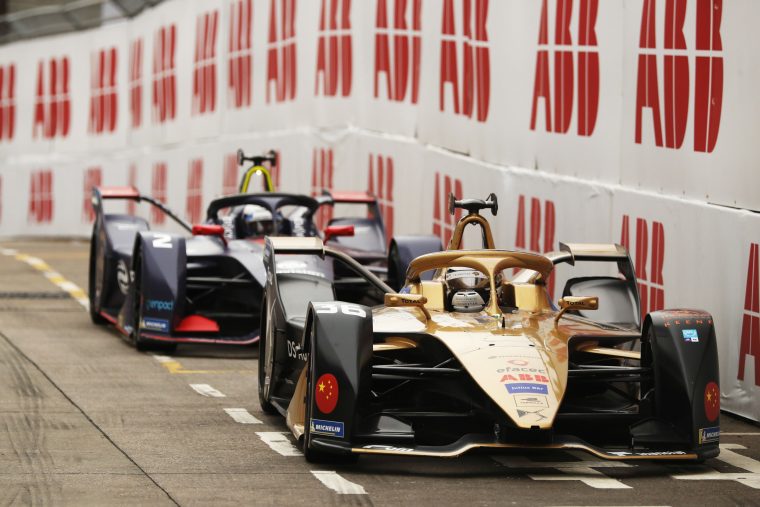Contact in Formula E – parity or fallacy?
Every time you’ve tuned in to watch a Formula E race, you’ll have noticed it has taken place in a city. The first track you ever saw was in the midst of a concrete jungle, and with tight, unforgiving walls separating the racing from the bustling city life.
The next race you watched was the same. And the next one. And the one after that, even up to the most recent race you’ve made sure to see. The one in a couple of weeks time will follow suit. Formula E’s DNA is woven with the molecular strands of urban being. The logistics are compromised, so the link between racing and the relevant world are not.
And what comes of an ever-present reliance on only the most populated areas the world can offer? Close boundaries. Every race in this series carries the dice-with-disaster stakes only tracks like Monaco and Marina Bay offer in F1, and that means the intense struggle to keep their cars out of the barriers and their fellow drivers is the name of the game.
Sometimes, as we saw this afternoon in Hong Kong’s central E-Prix, this spills over into the chaotic. Sam Bird and Edoardo Mortara were left on standby for hours after the race’s conclusion, waiting on the steward’s final call on who had actual claim to the victor’s trophy. Bird had clattered the rear diffuser of Andre Lotterer’s DS Techeetah on the final lap, placing him in the lead and on top of the podium while the powers-that-be investigated proceedings.
After a stretched deliberation, the stewards saw fit to slap Bird with a five-second time penalty, seeing his last-lap bash with Lotterer as breaking sporting conduct. On the face of it, this seems fair – only contact with the Envision Virgin Racing man could be pointed towards when Lotterer was seen limping a right-rear tyreless machine to the end.
But in the context of what the sport entails, and what it has been willing to forgive in the past, is it an example of good decision making or a contradiction to the norm? As previously stated, Formula E takes place only on some of the most unforgiving circuits you’ll see in racing. This naturally lends its hand to there being less space to play with, but as many cars on circuit as series such as F1.
Contact is bound to happen more frequently, and so it does. We see it in almost every E-Prix – like in stock car racing and DTM, Formula E drivers are fairly trigger-happy with the love tap. Hong Kong in particular gave host to plenty a nosecone taking a dive into another car’s rear diffuser, particularly in the heavy braking zones. It’s a shock to the senses to see open wheel cars used in this way; a F1 car’s front wing would shatter if you stared at it the wrong way, let alone nudged it against the rear of another car.
It’s commonplace and also hard to outlaw, especially when everyone’s at ease with the practice. Bird’s instance was more of a common tap, however. Lotterer’s rear diffuser was left damaged and his right-rear tyre was delaminated due to the contact, but the consequence of Bird’s action doesn’t specify whether the action itself was unjust.
Lotterer was in a situation where, on the run down to Turn 2, Bird had a sizeable gap on the inside to launch his machine down, but Lotterer’s win was at stake and he was in no mood to leave the attempt unchallenged. Lotterer appears to squeeze Bird to the point where there are two options – Bird scrapes against the inside wall, with the potential of getting away with it but also stuffing his car into the barriers, or he nudges Lotterer’s DS Techeetah while backing out of the move. As it is, Bird went for the latter and both races were compromised.
Also, there had been other incidents of a similar nature in the race. Robin Frijns had earlier made his mark on Sebastien Buemi’s Nissan e-dams, rendering the Swiss out of the race with damage. Frijns received no penalty for his troubles, begging the question – did the fact Lotterer and Bird’s crash took place in a fight for the lead skew the decision making?
Short answer, no. Even only within Season Five, there have been penalties handed out aplenty, for drivers all across the grid – Alexander Sims’ comes to mind, after his altercation with Mortara in Santiago, also on the final lap. Given the argument over whether Bird’s penalty should have been given is moot, the question of whether it would have been a contradiction to usual proceedings is what’s important – and that’s also a no. Frijns’ incident is the outlier among the process, if anything.
Contact is an inevitable consequence of Formula E’s nature. Immovable objects battling with unstoppable forces, all on the most claustrophobic of circuits, is bound to breed incident. But Bird’s penalty at Hong Kong, while certainly debatable, has fallen line astern with the stewards’ usual standards, and has not portrayed Formula E’s racing integrity to be a fallacy.





 No part of this website or any of its contents may be reproduced, copied, modified, adapted, used or distributed without the prior written consent of the author. e-racing.net is not responsible for the content of external sites or links.
No part of this website or any of its contents may be reproduced, copied, modified, adapted, used or distributed without the prior written consent of the author. e-racing.net is not responsible for the content of external sites or links.